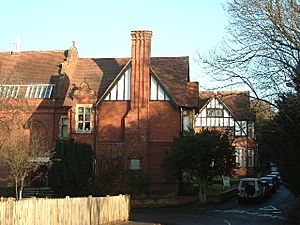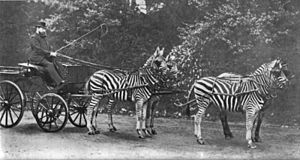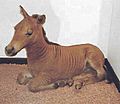Natural History Museum at Tring facts for kids

View of the oldest part of the museum; there are extensive buildings to the rear and left.
|
|
| Established | 1889 |
|---|---|
| Location | Tring, Hertfordshire, United Kingdom |
| Type | Mounted zoological specimens |
| Collection size | At least 4000 objects |
| Visitors | 151,787 (2019) |
The Natural History Museum at Tring is a super cool place to explore the animal kingdom! It used to be the private collection of a man named Lionel Walter, 2nd Baron Rothschild. Today, it's part of the famous Natural History Museum, London. This museum has one of the best collections of stuffed animals in the United Kingdom. You can see amazing mammals, birds, reptiles, and insects. The museum is located in Tring, Hertfordshire.
Contents
Discovering the Museum's History
The Natural History Museum at Tring started as a private museum. It belonged to Lionel Walter, 2nd Baron Rothschild. The museum is on the land where the Rothschild family used to live, at Tring Park. The building was finished in 1889. It was built to hold Walter's huge collection of mounted animal specimens. The museum first opened to the public in 1892.
In 1937, the Rothschild family gave the museum and all its amazing contents to the country. Walter Rothschild was very interested in animals. He even bred special animals called zebroids, which are a mix of zebras and horses. You can see a young zebroid on display at the museum! Walter was also famous for riding around in a carriage pulled by zebras. The museum's Zebra Cafe reminds visitors of his love for these striped animals. It even has pictures of his trained zebras.
Exploring the Animal Collections
The museum has a huge collection of animals spread across several rooms. You can see animals that are now extinct, meaning they no longer exist. These include the quagga, thylacine, and great auk. There are also models of the moa and dodo. The museum also shows unusual animals, like hybrids and those with strange color patterns.
After World War II, the dog display moved here from the Natural History Museum in London. This exhibit shows how different dog breeds have changed over time. It includes tiny Russian and Mexican lapdogs and famous racing greyhounds.
The museum has six main galleries, each with different types of animals:
- The first gallery features birds, large meat-eating animals called carnivorans, and primates.
- The second gallery is used for special exhibits that change over time.
- The third gallery displays crocodilians, crustaceans, fishes, insects, large mammals, and marine invertebrates.
- The fourth gallery is home to kangaroos and odd-toed ungulates (animals with an odd number of toes).
- The fifth gallery has bovids (like cows), hippopotamuses, pigs, and marine mammals.
- The sixth gallery shows amphibians, bats, various British mammals, domestic dogs, ratites (large flightless birds), lizards, snakes, turtles, and small mammals.
There's also a Discovery Room, which is perfect for younger children. The Rothschild Room looks just like the family's old workspace. The museum became part of the Natural History Museum in 1937. Its name changed to the Natural History Museum at Tring in April 2007.
The museum also has important bird research collections and a bird library. These are used by scientists and are not open to the public. However, the museum often has small, special exhibitions throughout the year. These shows display specimens that are not usually seen. They also offer fun activities for young visitors.
Protecting Museum Treasures
Museums work hard to protect their valuable collections. Sometimes, people try to steal from them.
Bird Specimens
In 2009, some brightly colored stuffed birds were taken from the museum. These included beautiful trogons and quetzals from Central and South America. There were also birds of paradise from New Guinea. Some of these birds had been collected by the famous scientist Alfred Russel Wallace. Most of the bird specimens were found and returned to the museum. This event was even featured on a radio show called This American Life, in an episode titled "The Feather Heist".
Rhinoceros Horns
In 2011, someone broke into the museum and tried to take horns from two rhinoceros exhibits. One was an Indian rhino and the other a white rhino. Luckily, the museum had already taken steps to protect these valuable items. A few months before the break-in, the museum replaced the real rhino horns with fake ones made of resin. These fake horns had no value. Real rhino horns are very valuable because some people believe they have special qualities.
Gallery







